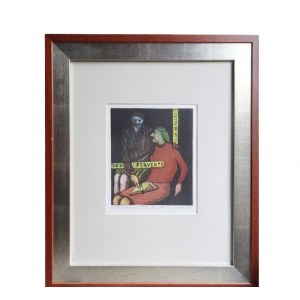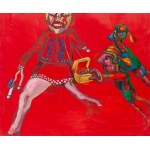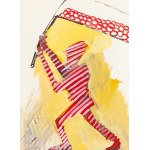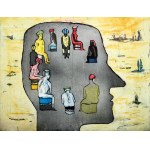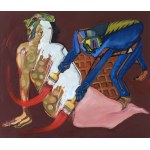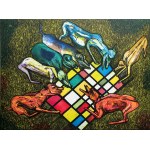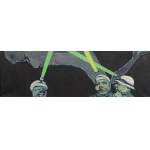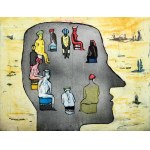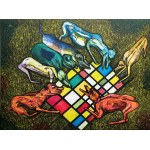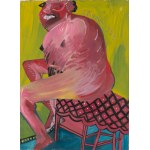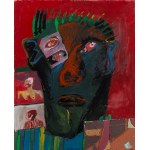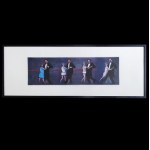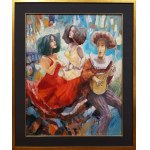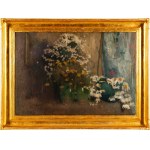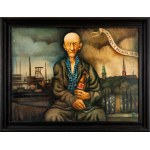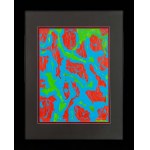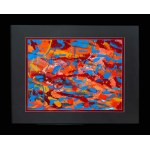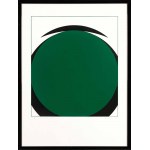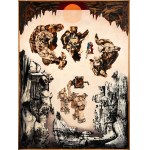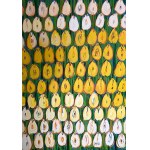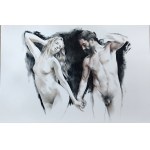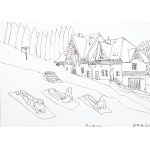Etching, aquatint, framed, 54 x 64.5 x 3.5 cm, signed and dated.
Sale price of works by Jacek Sroka onbid: PLN 11,400, PLN 7,200, PLN 8,260.
Jacek Sroka
In 1976, Jacek Sroka began his studies at the Faculty of Graphic Arts at the Academy of Fine Arts in Cracow. He chose Mieczyslaw Wejman's copperplate studio as his main specialty, plus drawing under Adam Hoffman and painting under Jan Świderski. This mixture of authorities and various inspirations helped him choose his artistic path, in which metaphorical thinking and intellectual analysis were enriched by an expressive, but always color-sensitive form. However, it is the break from the Academy that will account for the originality of his early works and their unbridled "wildness," breaking aesthetic norms. The artist defended his diploma in 1981 and remained at the Academy as an assistant in the intaglio studio, and then in the copperplate studio, until 1989. At that time he participated in the Independent Culture movement, designing covers for underground publications.
In 1985, Sroka held his first exhibition - at the Gologórski and Rostworowski Gallery in Cracow. From the mid-1980s, the artist collaborated with Berlin's Asperger Gallery and Warsaw's Gallery of Graphics and Posters. At the end of the decade, he established a cooperation with Jan Fejkiel (Krakow's Art Gallery, Jan Fejkiel Gallery), which continues to this day. In 2002 he was awarded the Witold Wojtkiewicz Prize. His achievements to date were shown in a retrospective exhibition of graphic and painting works, which took place in 2008 at the National Museum in Cracow.
Jacek Sroka closely observes reality and colorfully, yet perversely, describes it. Although the vision of the world and reflection on the twisted nature of the human psyche that emerge from his works are bitter, they are sweetened by pastiche and irony. The artist views reality through the prism of the grotesque and tames it with distance and layers of black humor. The sources of this art, as well as the specificity of Jacek Sroka's imagination, should be sought primarily in the Cracow school of graphic art firmly anchored in the tradition of Witkacy or Roman Jaworski. This school also drew on the writings of Franz Kafka and pre-war expressionist theater - idyll collided in it with horror, and pathos with vulgarity and perversion.
Already during his studies, Sroka supplied satirical drawings to the factory newspaper Echo of Construction, revealing his ability to think in a condensed and ironic manner. In the last years of his studies at the Academy, he searched for an individual form that corresponded both to the needs of youthful fantasy and to the times of political ferment of the late 1970s. He found it in a strongly expressionistic, deformed shape, in figurativeness carrying an ambiguous and often multi-stage message. He is no stranger to semantic play, as well as to referring to cultural heritage, merging into one different, often extremely incompatible visions, surprising the viewer with perverse titles of works. The artist's oeuvre is multifaceted, but his basic theme always remains the human being.
The experience gained from contact with printmaking, as well as the predestination for painterly vision, translate in Sroka's case into two independent tracks of artistic expression. The artist does both etching with aquatint and easel painting. He creates cycles to which he returns even after years. He makes drawings, which, although they are autonomous works, are generally, however, daily notes - sketches used in further work.
After 1981, Sroka's first painting series ("Byzantine Cycle," 1981-1984) was created, showing perverse images of Leonid Brezhnev and Felix Dzerzhinsky, among others, set against golden backgrounds. It was the artist's commentary on the paranoid political and social situation of martial law. Gold as an expression of divine emanation and hieratic silhouettes of the heroes of the paintings situate these portraits in the row of idols - contemporary icons, which the painter deals with by means of mockery and derision. Since then he has kept his distance from all idealization - of authority and history, of the Church and the state - seeing it as one of the most significant threats to man. Martial law was also reflected in his prints, such as "Thirteenth Twelfth" (1982) and "1982" (1985).
Initially, the artist creates small-format engravings, including the series "Hammer on Witches" (1982-1987) - a collection of dozens of black-and-white prints treating human violence and aggression, created on the basis of a manual of medieval inquisitors. These prints, with sharp, cut lines, closer to splatters than lines, show people with deformed faces and with quartered bodies. Once again, the artist brings the viewer into confrontation with a diagnosis that runs throughout his work: the difference between "Satan" and his conquerors is fluid and conventional.
Gradually, the aggression shown in the graphic works turns into sadomasochism, accompanied by an increasingly sharply emphasized erotic theme (graphic and painting series "The Cases of the Agent of the State Secret Police", 1984-1987). Filled with a dark aura, the works lead the viewer into dangerous alleys where bullies, policemen and thugs lurk. The artist constructs a plastic study of fear. He shows the human condition suspended between the need to inflict suffering and consent to it, between the need to rule and servility. The sharpness of the message is emphasized by aggressive colors based on strong contrasts ("Agent 2", 1987), a "wild" form derived from the aesthetics of ugliness and programmatically clumsy drawing. The instruments of torture, prisons, mysterious men emerging from the darkness, present in the works, are staffage in the story of human savagery and fear lurking in the human mind. Characters from the underworld and even the margins of society, introduced in the graphics, further enhance the atmosphere of eeriness and horror. Man's innate survival instinct often finds its metaphor in the silhouette of a dog - a friend who can become an aggressor in the blink of an eye.
Since around 1984, the form of Sroka's graphic works has been condensing, although the artist still echoes the brutal, primitive rasp. He diversifies his compositions, introduces plans, and with increasing skill creates a space saturated with overpowering fear ("White Volga," 1984; "The Life of a Subaltern," 1987).
In works from the late 1980s, Sroka increasingly boldly transforms both great existential themes and cultural icons into laughter and mockery ("The Arrival of Venus in the Red World," 1987; "Don Giovanni," 1988; "Nymph," 1989; "Coffin Portrait of a Nurse," 1988; "Odalisque," 1989). More often, he also uses strong, dissonant color combinations based on harsh blues, greens and reds to enhance expression.
In the 1990s, the expressiveness of Sroka's paintings calms down, and the artist makes more intensive use of literary, historical and philosophical inspirations, but never loses sight of street life and its social color. He is interested in stories seen, heard or read, anything that stimulates the imagination - as much the body of St. Sebastian as the soul of Casanova and the spirit of the eremite. He creates commentaries on history ("A Man Somewhat Like Lenin," 1995) and the Bible ("The Shower," 1994). The chiseled, primitive form of previous years is giving way to downright decorative compositions. The artist seduces the viewer with his ability to create an illusionistic shape ("Salon painting," 1993).
He uses modest multiplications at first ("Death in Water," 1990) to eventually "spread" a recurring motif across the canvas ("Wallpaper in Torture," 1992) or hang a curtain of repeated utensils in front of the viewer ("Five Good Deeds," 1993; "School for Girls," 1993). In this way he finds a form for a story about the paradox of evil, which is tamed and tamed by repetition and mass.
Among other things, Sroka creates perverse "view boards" that visualize the phenomenon of enslavement, dividing the canvas plane into individual sequences describing the magnificence of this phenomenon ("Colorful Aspects of Being a Servant," 1999). In another artistic endeavor, he juxtaposes seemingly incongruous subjects - lovers with an airborne invasion or pleasant beachcombing with the tendrils visible under a layer of sand. And this, in turn, leads him to look at what is hidden - in the ground, in cities, in buildings - and create mysterious stories (series "City", 1994-2002).
In 1992, a large-format etching "Construction of the World" is created, in which Sroka reaches out to Masonic and religious themes, creating an apocalyptic vision with the help of mystical signs. The graphic already shows a far-reaching affinity with painting. The painting will henceforth serve as an artistic prototype for the printmaking, which, heavily processed, repeats the painting theme, often taken up only years later. The engraving thus acquires painterly characteristics, becoming, in a way, a "reproduction" of the painted work. It is dominated by color, and drawing loses its sharpness and firm priority.
The artist replaces the previous color cacophony with sets of even monochromatic colors, limiting the palette to two colors ("Red-Pink Picture," 1994) or even one. Increasingly, he uses a texturally sophisticated canvas structure ("Man from the Hill," 1999), especially where he tells stories that inspire fear. It does not soften the message, but rather thickens and intensifies it. Sroka also uses a similar procedure when the beauty of color and form is juxtaposed with the thought of the ultimate cause - death ("The Reaper," 1999).
In the series "Masonic Cemeteries," created in 1996-2000, the artist takes the viewer through the mystery of initiation. The stone, adjacent gravestones seen from a bird's-eye view are generally made in a single color tone. Here, color also sets the tone for interpretation - the red and white cemetery is fundamentally different from the gray and blue one (1996) or the one dotted with green cypresses (1997). Inspired by Masonic themes, the artist captures the aura of the uncanny that accompanies these rituals ("Masonic Ritual Bathing Costume," 1999), but also a kind of bad name. Sroka also devotes a lot of attention to cabala, alchemy and libertinism - efflorescences of Enlightenment thinking, and especially to the forgotten French writer Restif de la Bretonne, author of "Nights of Paris," a colorful, amoral character, by all means authentic in his libertinism ("Restif de la Bretonne," 1995).
After 2000, the artist's spectrum of interests continues to broaden. Autobiographical motifs mix with journalistic, social, historical and political ones. Sroka is still interested in deeply existential issues, but also in the domain of health, bodybuilding, good nutrition, leisure activities. In the series "Symbiotec" (2000-2009), the leitmotif is the open viscera of a car showing a complex system of pipes and valves, into which the human figure perfectly integrated with the engine has been inscribed. Man addicted to technology becomes a contemporary allegory of voluntary enslavement. Chasing prosperity, moved on a gantry like a wagon ("Czyzinski Roundabout", 2007), he seems a creature all the more tragic because he is unaware of anything.
And even when in recent years Sroka's painting shifts its focus to the study of painting matter, he will never stop demystifying human limitations. He finds them everywhere, above all in banal everyday life ("Our Class," 2008; "Car Credit," 2010). He refers again to the civilizational heritage ("Don Quixote in the Kitchen," 2001; "Night Watch," 2007), as well as popular culture (the "Tattoos" series, 2007-2008), weaving in images of boxers, bodybuilders, beach bums, trendsetters in sweatpants or Superman. He reaches for kitsch, often balancing on the border of good taste. He shows the pauperization and tabloidization of life, the savagery of customs ("Girls from the Suburbs", 2002), the pursuit of journalistic sensationalism ("Criminal-Industrial Picture", 2002), indiscriminate, boorish behavior, but also those subjected to the rigors of civilization banalization ("Sausage Party", 2006). He creates a kind of catalog of trivial existence, as well as a vocabulary of the suburban subculture increasingly taking over our lives. He seeks new means of expression for kitsch, reaching for portraiture, including collective portraiture, and often a kind of genre painting, dosing successive installments of his painting stories like a popular series.
In the series "Geronimo" (2003-2007), he introduces a slushy, gritty texture of paint, and uses a spatula to apply thick layers of it to give the image of the legendary Apache chief, a primal force, an archaic power, which he has to contend with crammed into the four walls of a small bathroom. From the artist's childhood fascination with books about Indians, a mature confrontation with the world of myth is born. Here, the artist returns to his earlier reflections on the boundary between perpetrator and victim. However, in this case Geronimo is unequivocally an enslaved hero, and the several paintings about him are a kind of settlement, a kind of epitaph.
Sroka also constantly returns to building an atmosphere of horror ("Situation of a Six-Year-Old Girl," 2003). The artist tries to express fear in a painterly attractive way, suggesting how difficult it is to define when it becomes intertwined with our everyday life. Still another enriching element of Sroka's work is splashing, even throwing dark paint on the canvas ("Black Rain," 2005) or applying paint that imitates foam ("Foam," 2005).
In this sea of motifs, the artist also finds room for more personal confessions, as in the series "In caso di cattivi odori" (2005-2007), where vices and syringes driven into the feet express the painful consequences of the painter's illness. The series is a peculiar exemplification of the concept of pain, a story about a nagging state of permanent but perpetratorless torture. Sroka creates a record of the medication he takes, painted on small-format canvases ("Self-Portrait in December 2009," 2009). There is also a mockery of contemporary art, mainly the trend of so-called "banalism" with its fetishes of everyday life.
In the series "Komestyble" (2005-2006), showing images of foodstuffs with plastic flies glued to them, the artist speaks on the conceptual possibilities of art, including figurative art. He continues this theme in the series "Cleaning lady's intervention or the end of painting" (2009-2010), where, after a period of filling and multiplication, he shows something completely different: he demonstrates how one can play with emptiness and the notion of lack in a painterly way.
Detailed information about Jacek Sroka's exhibitions can be found in the catalog accompanying the artist's retrospective exhibition at the National Museum in Cracow in 2008.
Individual exhibitions after 2000:
2015 - "Jacek Sroka. Images in the Belly of Leviathan," Archetura, Cracow;
2014 - "Retrospective and Perspective Drawing," Jan Fejkiel Gallery, Krakow; "Pharmacological Self-Portraits / In caso di cattivi odori," Museum of Pharmacy, Krakow; "Observador diurno observador noturno. Gravuras de Jacek Sroka," Centro Cultural CEEE Erico Verissimo, Porto Alegre, Brazil
2013 - "Raw Beauty. Etchings by Jacek Sroka", EmArt Gallery, Ridgewood, NY, USA; "Observador diurno observador noturno. Gravuras de Jacek Sroka", Museu Oscar Niemeyer, Curitiba , Brazil; "Small Scandals", Arttrakt Gallery, Wroclaw, Poland; "Jacek Sroka. Small night guard", Gallery of Contemporary Art , Wloclawek; "Jacek Sroka. Mechanical Lovers. Paintings" Municipal Gallery BWA Tarnów; "Jacek Sroka. Construction of the World. Graphics", Oko Gallery for Art, Cracow
2012 - "Krakow Graphic Arts", Visual Art Center Tsingua University, Beijing, China; Exhibition in the Garden, Szczawno-Zdrój; "Momentaufnahmen", Haus der Modernen Kunst, Staufen, Germany; "Which World Will Survive", Erricson / Himmelberger Gallery, Menlo Park, USA; "Jacek Sroka, Several Paintings", Space Gallery, Krakow.
2011 - "Kayakers from Pinczow. Paintings 1987 - 2011", BWA Gallery, Kielce; "Bathing costume with Masonic ritual", BWA Gallery, Municipal Art Center, Gorzow Wielkopolski; "Graphics and drawings", Mozaika Gallery, J. Kochanowski Common Theater, Radom. Kochanowski, Radom; "Attack on the Miss Wet T-shirt Contest," Municipal Art Gallery, Zakopane; "Europe without Poland," Graphics and Poster Gallery, Warsaw; "Twenty-something paintings, including four bath paintings," Dom Chemika Gallery, Pulawy; "Jacek Sroka Painting Graphics",Lubuska Land Museum, Zielona Gora; "Either thick or flat, or a little thick and a little flat," BWA Gallery, Krosno; "Torture wallpaper," BWA Gallery, Pila; "Homemade bombs - paintings and graphics", BWA Gallery, Ostrowiec Swietokrzyski; "Danger of the city ( 3 ) - painting, graphics ", BWA Gallery , Zamek Książ, Walbrzych; "Danger of the city ( 2 ) - painting, graphics ", Art Gallery, Legnica; "Jacek Sroka , Paintings ", National Museum of Przemysl Land, Przemysl; "Danger of the city - painting, graphics", BWA Art Gallery, Jelenia Gora
2010 - "Intervention of a cleaning lady or the end of painting in nine paintings, including two mirror paintings", Artemis Gallery, Cracow; "Tattoo with Che - paintings, graphics, drawings ", House of Art, BWA Gallery, Rzeszow; "Night guard - paintings of recent years", BWA Galeria Zamojska, Zamosc; "Sausage swearing", Arttrakt Gallery, Wroclaw; "Jacek Sroka - paintings and graphics", BWA Gallery, Nowy Sacz; "Jacek Sroka. Etchings ", Martha Street Studio Gallery ( MPA ), Winniepeg, Canada.
2009 - "Conscience du temps", A.del Gallery, Lyon, France; "Peintures", Galerie Oberkampf, Paris, France; "Painting", MBWA Gallery, Olkusz.
2008 - "Jacek Sroka. Malerei aus Polen," Kunstverein Offenburg - Mittelbaden, Offenburg, Germany; "Jacek Sroka . Painting, graphics", Kunst # Stuecke, Galerie fur Mitteleuropaische Kunst, Vienna, Austria; "Jacek Sroka graphics, painting , drawing" , National Museum in Cracow, Cracow
2007 - "Drawings", Gallery "A", Faculty of Architecture, Cracow University of Technology, Cracow, Poland; "Paintings", Asperger Gallery, Maulbronn, Germany; "Menschlich", Haus der Modernen Kunst, Staufen-Grunern, Germany; " 87 drawings",Gallery of the Faculty of Graphics, Academy of Fine Arts, Cracow, Poland.
2006 - "Jacek Sroka , Peintre- Graveur", Galerie Orpheu, Liege, Belgium; "Paintings", Asperger Gallery, Berlin, Germany; "Beneath the surface", Himmelberger Gallery, San Francisco, USA; "The double meaning of landscapes", Tinhorn Press Gallery, San Francisco, USA.
2005 - "Jacek Sroka, Peintre - Graveur", Musee d'Ussel (gravures); La Grange (peintures), Ussel, France; "Schilderijen en Etsen",Galerie Post+Garcia, Maastricht, Netherlands.
2004 - Galerie Garcia-Laporte, Paris, France; MMG Gallery, Tokyo, Japan; "Don Quixote in the Kitchen",Jan Fejkiel Gallery, Cracow; "World,which cannot disappear", GP Gallery, Warsaw; Pinxit Gallery of Modern Art, Torun, Poland; "Wallpaper in Torture", W.Siemaszkowa Theater, Rzeszow, Poland; Polska Institutet, Stockholm, Sweden.
2003 - MMG Gallery, Tokyo, Japan; Small Gallery, Nowy Sącz; Galeria Na Prowincji, Pcim; "Ironisch-Satirisch", Galerie K. Staufen-Grunern, Germany.
2002 - W.Wojtkiewicz Award, ZPAP Pryzmat, Cracow.
2001 - SOMA (Gallery of Graphics and Posters), Warsaw; ZPAP Sukiennice Gallery, Cracow; "Alter Ego", The Project RM, San Francisco, USA; Mestna Gallery, Nova Gorica, Slovenia; Gallery of Contemporary Art, Sandomierz; Green Gallery, Busko Zdroj
2000 - Jan Fejkiel Gallery, Cracow; Biuro Wystaw Artystycznych, Kielce; Gallery of Contemporary Art, Przemyśl; Na Styku Gallery, Chrzanów; Galeria Obecna, Jaworzno City Museum, Jaworzno.



